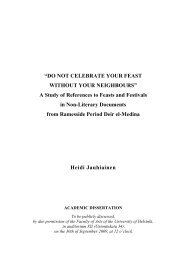BIA
bia51
bia51
Create successful ePaper yourself
Turn your PDF publications into a flip-book with our unique Google optimized e-Paper software.
MAI 2015<br />
Bureaucracy is another problem. After the<br />
revolution, many heads of different sections<br />
were afraid of signing paper work. The National<br />
Museum of Egyptian Civilisation (NMEC) and the<br />
Mallawî Museum were true examples of<br />
bureaucracy. I have now signed the papers on<br />
my own responsibility, and the work has<br />
resumed. The Mallawî Museum is to be officially<br />
inaugurated soon. Another phase of the NMEC<br />
is to be opened in July.<br />
The lack of security is a third problem, and<br />
we are trying to fill the gap through the<br />
installation of new electronic security systems<br />
like the one newly installed in the Luxor<br />
Museum. The lack of specialist restorers is a<br />
fourth problem, since the ministry has a large<br />
number of restorers but most of them are nonspecialist.<br />
This led to the improper restoration<br />
of the Tutankhamun mask.<br />
I have created a new section in the ministry<br />
for restoration in order to provide specialist<br />
restorers, meaning that it will soon have<br />
restorers specialising in metals, wood, glass,<br />
stone, papyri and so on. Training for restorers<br />
will also be introduced in collaboration with<br />
Germany, Italy, Japan and the United States.<br />
The social media is a fifth obstacle, as<br />
incorrect material appears on the Internet.<br />
— What is the ministry’s policy regarding<br />
the return of illegally smuggled antiquities?<br />
Since I entered office almost 500 artefacts<br />
have been returned from France, Switzerland,<br />
and the United States. A collection is to come<br />
back from Australia soon.<br />
Can you comment on UNESCO Director-<br />
General Irina BOKOVA’s visit this week to Cairo<br />
to attend a conference on cultural properties<br />
under threat in the Middle East?<br />
Irina BOKOVA is to inaugurate the conference<br />
and will pay a visit to the MIA to inspect the<br />
rehabilitation and restoration work carried out<br />
there, as well as signing the agreement for<br />
UNESCO’s $100,000 donation to the MIA. Her<br />
attendance is a great honour to the conference<br />
and sends the message that UNESCO is<br />
protecting all monuments, including those<br />
damaged during terrorist attacks. (Nevine El-<br />
Aref, “The future of the past”, Al-Ahram Weekly,<br />
May 14, 2015. Voir également « al-Damâtî : Je<br />
suis amplement satisfait du travail accompli par<br />
mon ministère », Ruz al-Yûsuf, 16 mai ; Amânî<br />
Abû al-Nagâ, « al-Damâtî : les médias publient<br />
des informations erronées et se focalisent sur<br />
les aspects négatifs », al-Shurûq, 17 mai ;<br />
Ahmad Mar‘î, « al-Damâtî : Je tente de<br />
ressusciter un ministère moribond », al-Yawm<br />
al-Sâbi‘, 22 juin).<br />
- -<br />
Vendredi 15 mai 2015<br />
A fire broke out in the grounds of a 19 th -<br />
century royal palace in Cairo but caused no<br />
damage to the historic building, officials said<br />
on Friday. Three fire vehicles were dispatched<br />
to the ‘Umar Tûsûn Palace in the district of<br />
Shubrâ in northern Cairo to extinguish the<br />
blaze. Photos from the site showed flames<br />
leaping from behind the wall of the palace.<br />
Muhammad ‘Abd al-Latîf who is head of the<br />
Islamic Antiquities Department at the Ministry of<br />
Antiquities, told Ahram Online that the fire<br />
broke out at a modern hall on the grounds of<br />
the palace, and didn’t reach the historical<br />
building. “Thank God the fire is contained and<br />
nothing has happened to the palace,” said ‘Abd<br />
al-Latîf, who added that the police were<br />
investigating the causes of the fire.<br />
‘Abd al-Latîf said that the halls on the site<br />
were built by the Ministry of Education in the<br />
1970s when the palace was in the possession<br />
of the ministry, and were used to store desks,<br />
tables and other equipment. The antiquities<br />
ministry, ‘Abd al-Latîf said, will ask education<br />
ministry to remove the items and clear the<br />
halls.<br />
The palace is a 3,200-square metre building<br />
on two storeys, with an arcade façade and a<br />
long terrace on its upper floor. It was built in<br />
1868 for Prince ‘Umar Tûsûn, who also<br />
<strong>BIA</strong> LI — Janvier/Juin 2015 122



